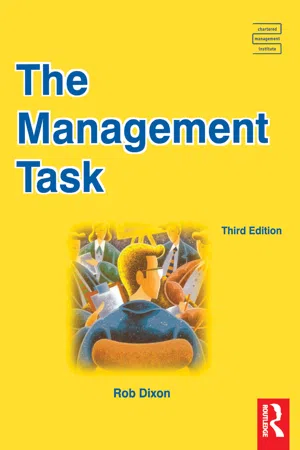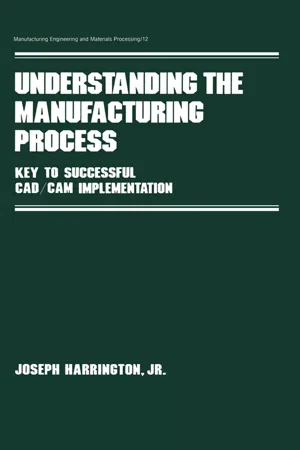Functions In A Business Firm
Functions in a business firm refer to the various departments and activities that work together to achieve the organization's goals. These functions typically include areas such as marketing, finance, operations, human resources, and more. Each function plays a crucial role in the overall success and performance of the business.
6 Key excerpts on "Functions In A Business Firm"
- eBook - ePub
- James P. Neelankavil, Anoop Rai(Authors)
- 2014(Publication Date)
- Routledge(Publisher)
...For example, international operations deal with the generation of goods and services for consumption by users. But to produce goods and services, the operations side of the business has to have the right personnel (HRM), and depends on the finance group for the necessary funds, the accounting department for control of the operations, the R&D department for technologically superior materials and innovative products, and the marketing department to use its resources for selling the goods and services. Individually, each function undertakes specific and unique activities that benefit from specialization. For example, assembly workers in a manufacturing plant that produces automobiles are more efficient in that function than at evaluating an investment opportunity. Evaluating investment opportunities is best left to the people in the finance department. Specialization results in more efficient use of resources within a functional jurisdiction. In-depth knowledge of a function and repeated use of the knowledge allows personnel within a function to be more productive; this is known as the learning-curve effect. Following is a summary of activities that fall under each of the eight functions. (A detailed treatment of six of the critical functions is presented in Chapters 8 through 13). P RODUCTION AND O PERATIONS M ANAGEMENT The following activities are associated with production and operations management. (See Chapter 8 for a more complete discussion of this topic.) S OURCING Sourcing is part of supply-chain management. International and domestic companies search globally for sources of raw materials and components to take advantage of lower prices and better designs: in some instances, a few countries serve as the exclusive sources for some raw materials. For example, Brazil is the largest producer of coffee beans and South Africa is the largest producer of diamonds...
- eBook - ePub
- Rob Dixon(Author)
- 2007(Publication Date)
- Routledge(Publisher)
...Part Three Management Functions C H A P T E R 11 Managers and departmental functions Any organization has several common departmental functions, which, although they may not all have such clear labels, are the means by which the organization gets its work done. The functions of production, marketing, finance and personnel can be detected in all organizations which exist to provide goods or services to others, regardless of whether they are businesses or not. These departmental functions are easily recognized in any company which manufactures goods to sell to others, but they are also present in service industries and in other organizations. Take a college or university, for example: here the production function is obvious the lectures and courses it holds for its customers its students. It has to market these courses in order to attract a new intake of students each year; while the finance and personnel functions are also obvious in such an organization. These functions are less clear, but still exist, in a very different organization, such as a church. Here, the ‘production’ function can be seen in the provision of church services and facilities for the local community, while the ‘marketing’ function can be recognized in the outreach work of many churches to those people outside the church. Managers in any organization will be concerned with one or more of these departmental functions at some point in their careers, although there are also other, more specialized, departmental functions in some businesses (e.g. computer and data processing departments)...
- eBook - ePub
Strategic Management
Theory and Practice
- John A. Parnell(Author)
- 2013(Publication Date)
- SAGE Publications, Inc(Publisher)
...For this reason, managers in all functional areas should understand how the areas should integrate, and they should work together to formulate functional strategies that fit together and support the corporate- and business-level strategies. This chapter examines functional strategies in the areas of marketing, finance, production, purchasing, HR, and IS. Although the relationships among functional strategies are not always clear, Table 8.1 summarizes the way functional strategies typically integrate with the business strategy using Porter’s cost leadership and differentiation strategies discussed in the previous chapter. Table 8.1 Integrating Business and Functional Strategies 1 This chapter is organized along functions. In practice, however, many of the issues discussed herein are cross-functional and therefore concern more than one functional area. Production warranties, for example, are a key concern for both the production and marketing departments. Marketing ___________________________________ The competitive strategy and the marketing functional strategy are tightly intertwined. Traditionally, marketing has been dissected into four dimensions or “four P s”: (1) price, (2) promotion, (3) product/service, and (4) place (i.e., channels of distribution). The particular generic strategy adopted by the business unit influences how these various dimensions are planned and executed. The emphasis on marketing—most notably the notion of customer orientation—continues to gain prominence and places a high level of importance on marketing strategies that support the firm and business strategies. 2 From a competitive standpoint, marketing is arguably the most critical of the functional strategies and should be considered early in the development of the business strategy. Pricing Strategies Business units that compete with the low-cost generic strategy produce basic, relatively undifferentiated outputs and often offer low prices...
- eBook - ePub
Introduction to Business
A Primer On Basic Business Operations
- Patrice Flynn(Author)
- 2019(Publication Date)
- Business Expert Press(Publisher)
...Labor contracts, wages, compensation, expectations, and performance are examined in this functional area. Every manager benefits from learning how to facilitate the ongoing process of harnessing and guiding people and other resources to achieve specific business goals. If you choose to take specialized business management courses, you will learn how to be an effective manager vis-à-vis the functions and roles you play as a manger. Wrap Up The above represents some of the key aspects of business that every businessperson needs to understand in order to appreciate the comprehensiveness of what we call business. While not all of the functional areas of business are covered in this primer, students will come away with a solid understanding of the key functional areas that will help guide their careers and future course of study....
- eBook - ePub
Understanding the Manufacturing Process
Key to Successful Cad/cam Implementation
- Joseph Harrington Jr.(Author)
- 2020(Publication Date)
- CRC Press(Publisher)
...It is focused on the task of steering the design, production, and support activities solely within the manufacturing function, and operates from the beginning to the end of each product’s life cycle, and on all currently active products. Please note that manufacturing management differs from the corporate management function, which is concerned with the entire enterprise; we must be specific. Hence the stress on “manufacturing.” Management occurs on all levels in a company. The Wall Street Journal reported (July 12, 1982) that the General Electric Company had 400,000 employees, 25,000 of whom had the word “Manager” in their title. The manufacturing management function, shown in Box 1 of Figure 3.2, is allocated the necessary funds to perform the total manufacturing function. The input is shown as an arrow entering the box, but the arrow head is surrounded by parentheses. This means that in the decomposition of this figure in later diagrams the distribution of the funds is implicit in the directives issued to the other functions, and will not be explicitly mentioned again. What the manager of manufacturing does distribute to the other functions in the department is a set of directives. They direct the Product Development function to develop and design products in accordance with the product definitions and requirements received from corporate management. They will include time schedules and budgets. They direct the Production function to produce a certain number of each product, on a time schedule and budget, in accordance with the designs received from the Product Development function; and they direct the Support Service of Products function to provide for spare and repair parts, operating and maintenance instructions, and the like. Of course, manufacturing management renders regular status and financial reports to the corporate management and support functions...
- eBook - ePub
Building an Outstanding Workforce
Developing People to Drive Individual and Organizational Success
- Paul Aldrich, Andrew Pullman(Authors)
- 2019(Publication Date)
- Kogan Page(Publisher)
...This view is supported by research which concludes that the human resource function has legitimacy in the organizations studied because the contribution of the human resource function to business effectiveness is perceived to centre on the business imperatives of performance and results; that human resource management strategies are rooted in business necessity; and that they are integrated with business strategy. 68 The need for business line managers to embrace their responsibility for the management of firm human resources is emphasized by those who believe that, given the significant financial impact, people management needs to be a core operational process and not solely a support function run by human resource professionals. Even slight changes in employee productivity have a significant impact on shareholder returns, therefore human resource management should no longer be seen as a support function but rather a core process for business line managers. 69 The above review identifies prescriptions for integrating business strategy and human resource strategy and notes that, while business line managers should take ultimate responsibility for the management of human resources, this is more likely to occur where human resource professionals and business line management relationships are themselves integrated through partnerships...





